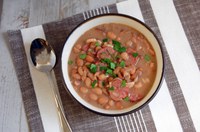Prairie Fare: A Taste of Brazil is Worth Trying
(Click an image below to view a high-resolution image that can be downloaded)
By Julie Garden-Robinson, Food and Nutrition Specialist
NDSU Extension
“Do you know what that is?” I asked.
My intern Larissa and I were strolling through a grocery store gathering her ingredients.
“That’s a pitaya,” she replied without hesitation.
I kind of expected she would know because the fruit is common in South and Central America. My summer intern is from Brazil.
I wish she would have been around when I bought a pitaya, or “dragon fruit,” for the first time a couple of years ago. We had several grocery store workers trying to figure out the name of this bright pink and green fruit that looks like a psychedelic artichoke. It has a white center with lots of tiny black seeds and tastes somewhat like a kiwi.
They couldn’t find the fruit in the online system, so they just made up a price. At the time, I also had a mob of people with full grocery carts waiting for me to get through the checkout line. They looked a little impatient.
My intern spent three weeks working with us in Extension, helping with a variety of nutrition education projects. She was especially amazed by how organized everything is in the U.S., including traffic.
I guess I shouldn’t complain about driving anymore.
She spoke Portuguese and English. I learned one Portuguese word. However, knowing how to say “hello” didn’t help me understand what ingredients she was seeking.
We found similar ingredients to make a Brazilian dessert, “brigadeiros,” which consists of sweetened condensed milk, cocoa, butter and chocolate sprinkles.
We found ingredients for “feijoada,” a Brazilian national dish made with black beans, pork or beef and sausage, and served with rice, orange slices and other sides.
You can find recipes for both on https://www.allrecipes.com.
We criss-crossed the store trying to locate similar items to what she needed. I think we became the talk of the store with all of our questions we had for the patient workers.
In fact, one of the workers asked us if we were buying food for a local concert venue. I guess the musicians have very particular tastes. I told them we were converting some Brazilian recipes to use American ingredients. They probably never had heard of that request, either. We had many bags of beans in our cart.
As I learned from my own trip to Central America a few years ago, people in South and Central America eat a lot of beans. Brazil produces and consumes more beans than anywhere. They eat about 33 pounds per person per year, often paired with rice.
In the U.S., we eat about 6.5 pounds of all types of dry beans per year.
We would do ourselves a favor if we ate more beans, such as pinto, navy and black beans. They are rich in soluble and insoluble fiber, low in fat and high in protein. Their unique nutritional profile makes them heart-healthy, and they may reduce our risk of certain types of cancer.
Beans and rice historically are paired for nutritional and culinary reasons; they are complementary proteins. Rice provides the sulfur amino acids (protein building blocks) methionine and cysteine, which beans don’t have. Beans contain the amino acid lysine that rice lacks.
Beans are available in canned, dry and other forms. Give dry beans a chance with these steps:
- Inspect the dry beans, removing any broken beans or foreign materials.
- Rinse the beans thoroughly in cold water.
- Soak the beans using the preferred method. Add 10 cups of cold water to the pot for each pound (2 cups) of beans. Bring the water to a boil, then boil for one to three minutes. Remove from heat and cover the pot. Let stand. A four-hour soak is ideal for high-quality beans. On average, 2 cups of dry beans yields 6 cups of cooked beans.
- Drain and rinse the soaked beans. Draining and rinsing the beans helps remove natural sugars that may cause intestinal gas.
- Cook the beans. Add fresh, cold water to cover the beans. Add 1 to 2 tablespoons of oil if you wish. Adding oil helps prevent foaming and boiling over. Heat to boiling, then reduce the heat to simmer gently until the beans are tender. Cooking times vary with the type, size and age of the beans, but generally cooking takes one to two hours.
While the beans are cooking, add more water if necessary to keep them covered. You should be able to mash the cooked beans easily between two fingers or with a fork. Alternatively, follow the manufacturer’s guidelines if you have a pressure cooker.
Here’s the traditional and delicious recipe that Larissa made for us. Check out the consumer education information at https://www.ag.ndsu.edu/food/bean-resources-1 to learn more reasons to eat beans and a lot of bean recipes to try, including desserts.
Traditional Brazilian Beans
9 ounces pinto beans, uncooked
2 bay leaves
3 1/2 ounces bacon, chopped
4 garlic cloves, chopped
5 ounces Kielbasa sausage, sliced
1 onion (small), chopped
Salt (to taste)
After sorting and rinsing the beans, soak them in water for 24 hours in the fridge (traditional method) or follow the quick-soak method. Drain and cook beans on the stove until softened. Add more water if necessary to keep them covered. In a pan, saute garlic, onion, bacon and sausage. Drain fat. Mix together all ingredients and simmer for 15 minutes.
Makes 10 servings. Without added salt, each serving (about 1 cup) has 180 calories, 8 grams (g) fat, 8 g protein, 18 g carbohydrate, 4 g fiber and 200 milligrams sodium.
(Julie Garden-Robinson, Ph.D., R.D., L.R.D., is a North Dakota State University Extension food and nutrition specialist and professor in the Department of Health, Nutrition and Exercise Sciences. Follow her on Twitter @jgardenrobinson)
NDSU Agriculture Communication - July 18, 2019
| Source: | Julie Garden-Robinson, 701-231-7187, julie.garden-robinson@ndsu.edu |
|---|---|
| Editor: | Ellen Crawford, 701-231-5391, ellen.crawford@ndsu.edu |




